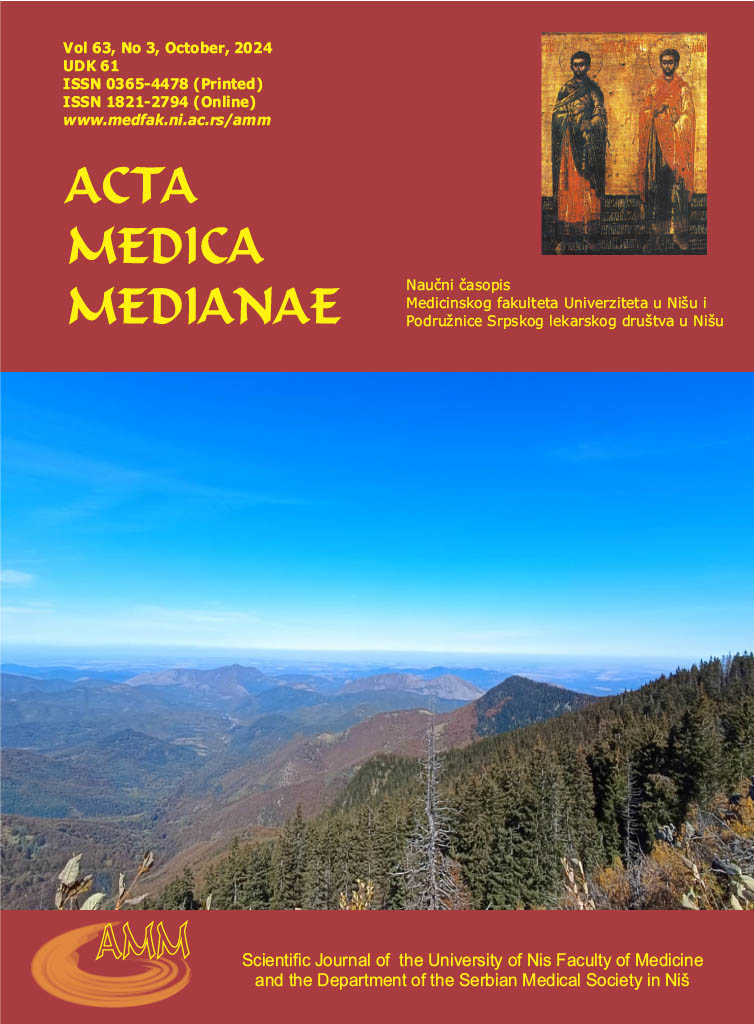HISTOLOŠKA PROCENA ODGOVORA KOŠTANOG TKIVA NA ENDODONTSKI MATERIJAL NA BAZI SILIKONA
Sažetak
Uspešan endodontski tretman podrazumeva da materijal za opturaciju ostane u tkivu, zauvek ako je to moguće. Stoga, neophodno je poznavati dugoročne efekte materijala na okolno tkivo. Cilj ove studije bila je histološka procena odgovora koštanog tkiva na materijal na bazi dimetil-polisiloksana implantiran u artificijelni preparirani defekt. Uzorak je obuhvatio 20 Wistar pacova. Defekt je formiran u mandibulama pacova sterilnim svrdilima od nerđajućeg čelika. Siler na bazi dimetil-polisiloksana (Roeko Seal) implantiran je u defekte pacova iz eksperimentalne grupe, dok su defekti pacova iz kontrolne grupe ostavljeni da spontano zarastu. Jedna polovina životinja iz obeju grupa žrtvovana je nakon 30 dana, a druga nakon 90 dana. Mikroskopski preparati su analizirani na svetlosnom mikroskopu. Fibrozni kalus i mlada kost uočeni su trideset dana nakon implantacije. Devedeset dana nakon implantacije, kost oko neresorbovanog materijala u potpunosti je zacelila. Roeko Seal ne usporava zarastanje koštanog tkiva i omogućava potpuno zaceljenje tkiva oko materijala.
Reference
Ashraf H, Shafagh P, Mashhadi Abbas F, Heidari S, Shahoon H, Zandian A, et al. Biocompatibility of an experimental endodontic sealer (Resil) in comparison with AH26 and AH-Plus in rats: An animal study. J Dent Res Dent Clin Dent Prospects 2022;16(2):112-17. [CrossRef] [PubMed]
Da Silva LAB, Bertasso AS, Pucinelli CM, da Silva RAB, de Oliveira KMH, Sousa-Neto MD, et al. Novel endodontic sealers induced satisfactory tissue response in mice. Biomed Pharmacother 2018; 106:1506-12. [CrossRef] [PubMed]
Dammaschke T, Schneider U, Stratmann U, Yoo JM, Schäfer E. Reaktionen des entzündeten periapikalen Gewebes auf drei unterschiedliche Wurzelkanalsealer. J Oral Rehabil. 2013; 17:264–8.
Derakhshan S, Adl A, Parirokh M, Mashadiabbas F. Comparing subcutaneous tissue responses to freshly mixed and set root canal sealers. Int Endod J 2009; 4(4):152–7. [PubMed]
Fonseca DA, Paula AB, Marto CM, Coelho A, Paulo S, Martinho JP, et al. Biocompatibility of Root Canal Sealers: A Systematic Review of In Vitro and In Vivo Studies. Materials (Basel) 2019; 12(24):4113. [CrossRef] [PubMed]
Garcia P, Histing T, Holstein JH, Klein M, Laschke MW, Matthys R, et al. Rodent animal models of delayed bone healing and non-union formation: a comprehensive review. Eur Cell Mater 2013; 26: 1-12; discussion 12-4. [CrossRef] [PubMed]
Gençoglu N, Türkmen C, Ahiskali R. A new silicon-based root canal sealer (Roekoseal®-Automix). J Oral Rehabil 2003;30(7):753–7. [CrossRef] [PubMed]
Ghanaati S, Willershausen I, Barbeck M, Unger RE, Joergens M, Sader R A, et al. Tissue reaction to sealing materials: different view at biocompatibility. Eur J Med Res 2010;15(11):483–92. [CrossRef] [PubMed]
Hauman CHJ, Love RM. Biocompatibility of dental materials used in contemporary endodontic therapy: A review. Part 2. Root-canal-filling materials. Int Endod J 2003; 36(3):147–60. [CrossRef] [PubMed]
Leonardo MR, Silveira FF, Silva LAB Da, Tanomaru Filho M, Utrilla LS. Calcium hydroxide root canal dressing. Histopathological evaluation of periapical repair at different time periods. Braz Dent J 2002;13(1):17–22. [PubMed]
Lodiene G, Morisbak E, Bruzell E, Ørstavik D. Toxicity evaluation of root canal sealers in vitro. Int Endod J 2008; 41(1): 72–7. [CrossRef] [PubMed]
Miletić I, Devcić N, Anić I, Borc¡ić J, Karlović Z, Osmak M. The cytotoxicity of RoekoSeal and AH Plus compared during different setting periods. J Endod 2005;31(4):307–9. [CrossRef] [PubMed]
Ogasawara T, Yoshimine Y, Yamamoto M, Akamine A. Biocompatibility of an experimental glass-ionomer cement sealer in rat mandibular bone. Oral Surg Oral Med Oral Pathol Oral Radiol Endod 2003; 96(4):458–65. [CrossRef] [PubMed]
Olsson B, Sliwkowski A, Langeland K. Subcutaneous implantation for the biological evaluation of endodontic materials. J Endod 1981; 7(8):355–69. [CrossRef] [PubMed]
Oztan MD, Yilmaz S, Kalayci A, Zaimoğlu L.A comparison of the in vitro cytotoxicity of two root canal sealers. J Oral Rehabil 2003;30(4):426-9. [CrossRef] [PubMed]
Santos GSBD, Carvalho CN, Tavares RRDJ, Silva PGDB, Candeiro GTDM, Maia Filho EM. Tissue repair capacity of bioceramic endodontic sealers in rat subcutaneous tissue. Braz Dent J 2023; 34(3): 25-32. [CrossRef] [PubMed]
Santos J, Pereira S, Sequeira D, Messias A, Martins J, Cunha H, et al. Biocompatibility of a bioceramic silicone-based sealer in subcutaneous tissue. J Oral Sci 2018; 61(1): 171-7. [CrossRef] [PubMed]
Silva EJ, Santos CC, Zaia AA. Long-term cytotoxic effects of contemporary root canal sealers. J Appl Oral Sci 2013; 21(1):43-7. [CrossRef] [PubMed]
Silva-Herzog D, Ramírez T, Mora J, Pozos AJ, Silva LAB, Silva RAB, et al. Preliminary study of the inflammatory response to subcutaneous implantation of three root canal sealers. Int Endod J 2011;44(5):440–6. [CrossRef] [PubMed]
Suzuki P, Souza V De, Holland R, Gomes-Filho JE, Murata SS, Dezan Junior E, et al. Tissue reaction to Endométhasone sealer in root canal fillings short of or beyond the apical foramen. J Appl Oral Sci 2011; 19(5):511–6. [CrossRef] [PubMed]
Tanomaru-Filho M, Tanomaru JMG, Leonardo MR, da Silva LAB. Periapical repair after root canal filling with different root canal sealers. Braz Dent J 2009;20(5):389–95. [CrossRef] [PubMed]
Trichês KM, Júnior JS, Calixto JB, Machado R, Rosa TP, Silva EJNL, et al. Connective tissue reaction of rats to a new zinc-oxide-eugenol endodontic sealer. Microsc Res Tech 2013;76(12):1292–6. [CrossRef] [PubMed]
Vujašković M, Bacetić D. Reakcija tkiva na materijale za trajno punjenje kanala korena zuba Tissue Toxicity of Root Canal Sealers. serbian Dent J. 2004;51:136–41. [CrossRef]
Washio A, Morotomi T, Yoshii S, Kitamura C. Bioactive Glass-Based Endodontic Sealer as a Promising Root Canal Filling Material without Semisolid Core Materials. Materials (Basel) 2019; 12(23):3967. [CrossRef] [PubMed]
Zafalon EJ, Versiani MA, de Souza CJ, Moura CC, Dechichi P. In vivo comparison of the biocompatibility of two root canal sealers implanted into the subcutaneous connective tissue of rats. Oral Surgery Oral Med Oral Pathol Oral Radiol Endodontology 2007; 103(5):88–94. [CrossRef] [PubMed]

